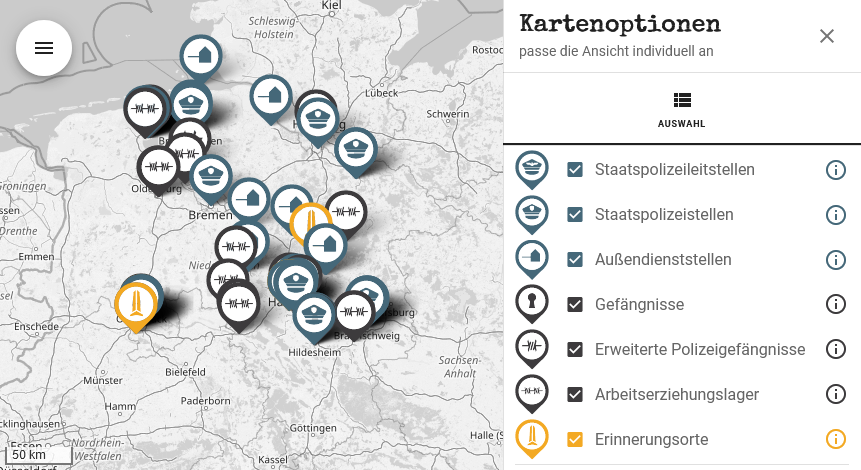Gestapo.Terror.Orte
in Lower Saxony 1933–1945

Where in Lower Saxony were places of Gestapo terror located? Which buildings did the political police use during National Socialism? Where did the Secret State Police have its headquarters and detention centres? How did transport services and routes, telecommunications and postal services affect the selection of sites at that time?
Answers to these questions will be provided within “Gestapo.Terror.Places in Lower Saxony 1933–1945”, a collaborative project being undertaken by the Lower Saxony Memorials Foundation and TIB – Leibniz Information Centre for Science and Technology. The project has received funding from Lower Saxony Ministry for Science and Culture (MWK) under the “PRO*Niedersachsen” funding initiative from the “Niedersächsisches Vorab” programme of the Volkswagen Foundation.
Traces of the past: making Gestapo crimes digitally visible
The project aims both to research the activities of the Gestapo with regard to its locations and infrastructure and to make available digitally the existing knowledge about the crimes of the Gestapo and the later memory of them. A four-dimensional map, in conjunction with Wikidata, serves to record archive, literature and other source material, evaluate it for research purposes and publish it as an interactive internet presence. The project further develops the open source prototype of the research database into a public resource that can be used and supplemented by memorials and educational institutions in Lower Saxony as well as by researchers, students and other interested parties.
Area-wide investigation of sites and infrastructure
The Gestapo was one of the key instruments of terror within the National Socialist state. The Secret State Police persecuted political and other opponents, enforced state-sponsored anti-Semitism and racism, and kept the war economy rolling.
“The Gestapo was given special powers: they was able to arbitrarily impose and execute penalties, they tortured their suspects and killed prisoners,” stressed Dr. Jens-Christian Wagner, Director of the Lower Saxony Memorials Foundation.
Shortly before the end of the Second World War, the Gestapo managed to destroy vast amounts of documents in what is now the Federal State of Lower Saxony, as was the case in many other regions, too. However, post-war investigations and parallel traditions in particular have enabled researchers to reconstruct the Gestapo’s activities.
The research project focuses on the places of Gestapo terror in the territory of what is now the Federal State of Lower Saxony. The objective is to investigate the then headquarters and detention centres throughout the region for the first time as fundamental factors of Gestapo activities.
“Gestapo sites and infrastructure are new fields of investigation. Until now, research focused mainly on the personnel, tasks and organisation of the Secret State Police,” explained Dr. Janine Doerry,
who advised the project proposers in her capacity as an employee of the Gedenkstätten Gestapokeller und Augustaschacht e. V. in Osnabrück.
Making historical heritage digitally accessible
Based on Gestapo sites and infrastructure, researchers should be able not only to investigate the activities of the Secret State Police, but also to make knowledge about their crimes digitally accessible, serving as a reminder. Being part of Lower Saxony’s cultural heritage, memorial site collections, thematic archive resources and monuments in particular will be accessed and investigated. Gestapo sites, which changed multiple times during the National Socialist era, and contemporary places of remembrance are to be portrayed in a four-dimensional digital map – showing location-based and time-related data. The research results will be made available to the public on the project website.
“We at TIB are responsible for digitally developing and preparing the data. We will ensure that data will be freely accessible, meaning that people will be able to use the data for educational work or for further research, for example,” explained Professor Dr. Ina Blümel from the Open Science Lab (OSL) of TIB, where the project is based.
During the establishment phase, TIB will be able to gain from the library’s experience in current projects such as GESAH and VIVO. The project is part of the new Open GLAM priority of the OSL. GLAM stands for “Galleries, Libraries, Archives, Museums”, i.e. cultural institutions and memory organisations that make their works freely accessible to the public under the term “Open GLAM”. The project will be launched in October, at the same time as NFDI4Culture – Consortium for research data on material and immaterial cultural heritage, which has likewise just been approved for funding.
Linking together data on Gestapo terror
“The digital map developed within the project incorporates not only the latest research findings, but also information on digital objects that already exist elsewhere,” stated Professor Dr. Blümel.
In particular, datasets on historic sites, institutions and events that are deposited in freely accessible databases such as the Digital Monument Atlas Lower Saxony, Wikidata, Wikimedia Commons, Pelagios Commons and Open Street Map are to be linked together. The data will be enriched by objects and descriptions on the websites of the Lower Saxony Memorials Foundation and individual places of remembrance in Lower Saxony, such as the localisation of the former Gestapo headquarters in the city of Braunschweig.
In addition, the platform is to be used for both school-based and non-school-based educational work.
“Besides using traditional methods of learning, local memorial sites can also be included, beyond the classroom. Concerning this, specific professional development measures for teachers, memorial site staff and other disseminators will be taking place in October 2020 as part of the “Coding da Vinci” cultural hackathon coordinated by TIB,” remarked Lambert Heller, Head of the OSL.
Citizen science: committed citizens wanted
Once the envisaged platform has been set up, it will be up to local citizens to become registered users and to keep adding information to the system. This is participation in the sense of “citizen science”, which gives amateurs the opportunity to get involved in scientific projects.



